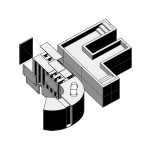ABOUT DESIGN (expanded)
ABOUT DESIGN (expanded)
My foremost passion is architecture, in large part because of all the theoretical, rhetorical, and technical baggage that the discipline entails. This of course, doesn’t preclude my branching out into different areas like print design, environment game design, or playground design. Taking advantage of the opportunities to be found in liminal fields is, I believe, something that comes with the title of (junior) architect as the skills and the people encountered during these endeavors cannot but add another dimension to architectural thinking. Now, if you’re thinking this statement seems a little redundant, especially considering how desperately architecture is currently trying to assimilate any field it deems of interest (think parametrics), or you think it seems a little late, considering the fact that architects have been calling themselves master builders for over half a millennia, you may be right. If most architects are generalists to some degree, then having multiple interests becomes somewhat expected, yet by that same token, it also adds greater weight to the way in which an architect approaches the cross-disciplinary. That is to say, perhaps the most insightful thing to know about a budding architect is the common foundation underpinning his/her pursuits. In my case, my interests have been defined by, and come to define, what I believe to be my greatest asset: my boundless capacity to critique.
Much in line with the thinking of certain architects, I’ve come to believe that innovative design, or at least, the design I’m attracted too, is less the product of technical advancement, scientific discovery or a positivist mindset, as it is the result of deconstructing prejudice. Thus, the commonality between my attraction to playgrounds, canes, the branding of schools, and even interacting with clients, is not so much a desire and capacity for new invention, as it is a desire and capacity to sometimes playfully, and sometimes painfully critique assumptions. The playground, my thesis topic, is a striking setting, not because it fits the parameters of a non-space( a left-over or transitional space), but rather because it’s a kind of assumed-space. (see There’s More to Playgrounds- a critique) It is not so much uninhabited, ignored, or disdained, as it is simply accepted; suffering from a kind of archetypal self-reference, (among other things) that allows people to overlook its flaws. Incidentally, this is precisely what makes it a great space for design intervention, not to mention an ideal anthropological mirror for architecture. My current endeavors in partnership with Neuro-Gym, are also driven by a similar mindset. My interest in canes and walkers doesn’t result from a new hinge concept or a new material, but rather the fact that most people simply assume these to be ugly and practical, one size fits all aids. The same can be said of my work branding Académie de la Capitale, a small private school (see Acadecap Branding). The crux of my branding/marketing strategy requires that the school be transformed into a gallery space for student work with well thought-out display spaces and polished framing mechanisms. A strategy which also requires the removal of all the motivational posters, flimsy corrugated borders, clutter, and all other signs, devices and materials usually associated with a school. The innovation here is once again, inseparable from the critique. School-bells, stickers, clip art, motivational posters, colored paper, banner lettering and other thoughtless filler have no pedagogical value, yet they are the very things teachers assume should be adorning their classrooms. Removing these becomes more than a first step towards a design, it becomes a large part of the design. F This situation is likely a familiar one to architects practicing residential design ( see The Acceptable Norms of Residential Design). It’s been my experience that a great deal of conversation goes towards undoing the client’s assumption of what a house can and should be. Only once such residential assumptions have been cleared can the design take shape. Like most projects though, the critique of such assumptions is not a precursor too, but the most informative part of the design process. Thus, because of both my experience, and likely because of my natural inclinations, I’ve come to believe that seeking out and undoing conventions, is often more radical and effective than simply attempting to be avant-garde could ever be.
